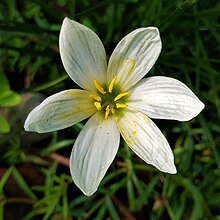| Zephyranthes candida | |
|---|---|

| |
|
Scientific classification
| |
| Kingdom: | Plantae |
| Clade: | Tracheophytes |
| Clade: | Angiosperms |
| Clade: | Monocots |
| Order: | Asparagales |
| Family: | Amaryllidaceae |
| Subfamily: | Amaryllidoideae |
| Genus: | Zephyranthes |
| Species: | Z. candida
|
| Binomial name | |
| Zephyranthes candida | |
| Synonyms [1] | |
| |
Zephyranthes candida, with common names that include autumn zephyrlily, [2] white windflower, [3] white rain lily, [4] and Peruvian swamp lily, [5] is a species of rain lily native to South America including Argentina, Uruguay, Paraguay, and Brazil. The species is widely cultivated as an ornamental and reportedly naturalized in many places ( South Africa, the Indian subcontinent, Zimbabwe, Seychelles, central and southern China, Korea, Nansei-shoto ( Ryukyu Islands), Bhutan, Solomon Islands, Queensland, Nauru, Tonga, Society Islands, Mariana Islands, southeastern United States (from Texas to North Carolina), the Lesser Antilles, and Peru). [6] [7]
Leaves are a deep glossy green and measure 3 mm wide. Flowers, which bud late in August (when propagated in the Northern Hemisphere) at first resemble a new leaf, but emerge from their papery sheaves to a stunning whiteness; they are erect in perianth white and sometimes pinkish abaxially. The leaf-like bract is 1.8 to 4 cm. They grow best in full sun to part shade and require a medium wet soil. Propagation is done by dividing bulbs or offsets and from seed. [8] [9] [10] [11]
Zephyranthes candida was first described by John Lindley in 1823 as Amaryllis candida. [9] It was transferred to its current genus in 1826 by William Herbert. [8] [3] Other common names of Zephyranthes candida include August rain lily, white zephyr lily, white fairy lily, white rain lily, and autumn zephyr lily.[ citation needed]
Cultivation
Hardiness: USDA zones 7-10.[ citation needed]
Chemical constituents
It contains lycorine, nerinine, haemanthamine, tazettine, haemanthidine, zephyranthine. [12]
See also
References
- ^ The Plant List
- ^ USDA, NRCS (n.d.). "Zephyranthes candida". The PLANTS Database (plants.usda.gov). Greensboro, North Carolina: National Plant Data Team. Retrieved 9 August 2015.
- ^ a b "Zephyranthes candida". Australian Plant Name Index (APNI), IBIS database. Centre for Plant Biodiversity Research, Australian Government.
- ^ "Zephyranthes candida". Germplasm Resources Information Network. Agricultural Research Service, United States Department of Agriculture.
- ^ "Royal Horticultural Society: Find a Plant". Retrieved 20 December 2014.
- ^ Kew World Checklist of Selected Plant Families
- ^ Biota of North American Program
- ^ a b Herbert, William. 1826. Botanical Magazine 53: pl. 2607, Zephyranthes candida
- ^ a b Lindley, John. 1823. Botanical Register 9: pl. 724, Amaryllis candida
- ^ Sasaki, Shun-ichi. 1928. List of Plants of Formosa 112, as Atamosco candida
- ^ Rafinesque, Constantine Samuel. 1838. Flora Telluriana 4: 10. as Plectronema candida
- ^ "Katoch D and Singh B, Med Aromat Plants" (PDF).
External links
| Zephyranthes candida | |
|---|---|

| |
|
Scientific classification
| |
| Kingdom: | Plantae |
| Clade: | Tracheophytes |
| Clade: | Angiosperms |
| Clade: | Monocots |
| Order: | Asparagales |
| Family: | Amaryllidaceae |
| Subfamily: | Amaryllidoideae |
| Genus: | Zephyranthes |
| Species: | Z. candida
|
| Binomial name | |
| Zephyranthes candida | |
| Synonyms [1] | |
| |
Zephyranthes candida, with common names that include autumn zephyrlily, [2] white windflower, [3] white rain lily, [4] and Peruvian swamp lily, [5] is a species of rain lily native to South America including Argentina, Uruguay, Paraguay, and Brazil. The species is widely cultivated as an ornamental and reportedly naturalized in many places ( South Africa, the Indian subcontinent, Zimbabwe, Seychelles, central and southern China, Korea, Nansei-shoto ( Ryukyu Islands), Bhutan, Solomon Islands, Queensland, Nauru, Tonga, Society Islands, Mariana Islands, southeastern United States (from Texas to North Carolina), the Lesser Antilles, and Peru). [6] [7]
Leaves are a deep glossy green and measure 3 mm wide. Flowers, which bud late in August (when propagated in the Northern Hemisphere) at first resemble a new leaf, but emerge from their papery sheaves to a stunning whiteness; they are erect in perianth white and sometimes pinkish abaxially. The leaf-like bract is 1.8 to 4 cm. They grow best in full sun to part shade and require a medium wet soil. Propagation is done by dividing bulbs or offsets and from seed. [8] [9] [10] [11]
Zephyranthes candida was first described by John Lindley in 1823 as Amaryllis candida. [9] It was transferred to its current genus in 1826 by William Herbert. [8] [3] Other common names of Zephyranthes candida include August rain lily, white zephyr lily, white fairy lily, white rain lily, and autumn zephyr lily.[ citation needed]
Cultivation
Hardiness: USDA zones 7-10.[ citation needed]
Chemical constituents
It contains lycorine, nerinine, haemanthamine, tazettine, haemanthidine, zephyranthine. [12]
See also
References
- ^ The Plant List
- ^ USDA, NRCS (n.d.). "Zephyranthes candida". The PLANTS Database (plants.usda.gov). Greensboro, North Carolina: National Plant Data Team. Retrieved 9 August 2015.
- ^ a b "Zephyranthes candida". Australian Plant Name Index (APNI), IBIS database. Centre for Plant Biodiversity Research, Australian Government.
- ^ "Zephyranthes candida". Germplasm Resources Information Network. Agricultural Research Service, United States Department of Agriculture.
- ^ "Royal Horticultural Society: Find a Plant". Retrieved 20 December 2014.
- ^ Kew World Checklist of Selected Plant Families
- ^ Biota of North American Program
- ^ a b Herbert, William. 1826. Botanical Magazine 53: pl. 2607, Zephyranthes candida
- ^ a b Lindley, John. 1823. Botanical Register 9: pl. 724, Amaryllis candida
- ^ Sasaki, Shun-ichi. 1928. List of Plants of Formosa 112, as Atamosco candida
- ^ Rafinesque, Constantine Samuel. 1838. Flora Telluriana 4: 10. as Plectronema candida
- ^ "Katoch D and Singh B, Med Aromat Plants" (PDF).